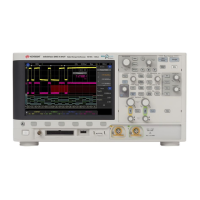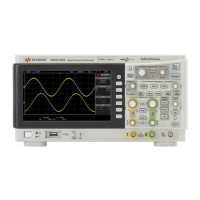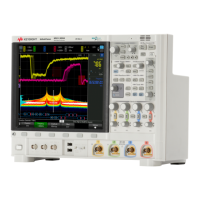What's New 1
Keysight InfiniiVision 3000T X-Series Oscilloscopes Programmer's Guide 35
Command Differences From 4000 X-Series Oscilloscopes
The Keysight InfiniiVision 3000T X-Series oscilloscopes command set is most
closely related to the InfiniiVision 4000 X-Series oscilloscopes (and the
3000 X-Series, 7000A/B Series, 6000 Series, and 54620/54640 Series
oscilloscopes before them).
The main differences between the version 4.00 programming command set for the
InfiniiVision 3000T X-Series oscilloscopes and the 3.20 programming command
set for the InfiniiVision 4000 X-Series oscilloscopes are related to:
• Dedicated FFT function (and selectable math functions — 4000 X-Series
oscilloscopes have four selectable math functions).
• SENT serial decode and triggering option.
• Updates to support CAN FD serial decode and triggering.
• Counter feature (when DSOXDVMCTR option is licensed).
• New built-in demo signals (with Option EDU license that comes with the
N6455A Education Kit).
• One waveform generator output (4000 X-Series oscilloscopes have two
waveform generator outputs).
•No 10MHz REF connector.
• No support for USB 2.0 serial decode, triggering, or signal quality analysis.
More detailed descriptions of the new, changed, obsolete, and discontinued
commands appear below.
New Commands
Command Description
:CHANnel<n>:PROBe:MMODel
(see page 278)
Sets the model number of the supported Tektronix probe.
:COUNter Commands (see
page 287)
Commands for controlling the optional DSOXDVMCTR counter
feature.
:DISPlay:ANNotation<n>:X1Pos
ition (see page 322)
Sets the horizontal position of one of the four annotations.
:DISPlay:ANNotation<n>:Y1Pos
ition (see page 323)
Sets the horizontal position of one of the four annotations.
:FFT Commands (see
page 345)
Commands for using the FFT function feature.
:FUNCtion<m>:CLEar (see
page 376)
When the :FUNCtion<m>:OPERation is AVERage, MAXHold, or
MINHold, this command clears the number of evaluated
waveforms.

